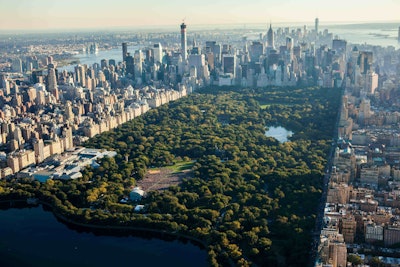 Central Park is comprised of 250 acres of lawns, 150 acres in seven waterbodies and 136 acres of woodlands.
Central Park is comprised of 250 acres of lawns, 150 acres in seven waterbodies and 136 acres of woodlands.Photo: Wikipedia
This week I will be traveling to New York with my family and I thought I’d take this time to share with you a little bit about some of the parks that I’ll be visiting there.
The first, and probably one of the most well-known parks in the country, I’ll be touching on is Central Park. The 843-acre park was America’s first major landscaped public park and its success fostered the urban park movement.
In 1853, the New York legislature signed a law using eminent domain to claim 750 acres in Manhattan to become a public park. The irregular terrain and swamps made the space undesirable for commercial development and also the wealthy New Yorkers wanted to have a public space reminiscent of European public grounds like those in London and Paris.
By 1858, the Central Park Commission held a design competition for the park, and Frederick Law Olmsted and Calvert Vaux were selected as the winners, beating out 32 other entries with their “Greensward Plan.”
The design was required to include a parade ground, principal fountain, a skating area, a lookout tower, four cross streets and an exhibition area for concerts and the like. Olmsted and Vaux met these requirements and designed the park to have a pastoral landscape. In fact, the Sheep Meadow for a period of time actually had sheep grazing there at Olmsted’s insistence.
 The Balto statue is one of the many different iconic figures you can find in the park.
The Balto statue is one of the many different iconic figures you can find in the park.Photo: Jill Odom
While the park looks naturalistic, some 20,000 workers labored 10-hour days to shape the landscape into what it is today. Nearly 3 million cubic yards of topsoil was moved and more than 270,000 trees and shrubs were planted. According to The Park and The People: A History of Central Park, to clear rocky outcrops they used more gunpowder than what was later used at the Battle of Gettysburg.
By winter 1859, the first portion of the park was open for New Yorkers to ice skate on one of the swamp areas that had been transformed into a lake. The Civil War slowed construction as most of the able-bodies workers had gone to fight and there was less money available.
Fifteen years and 7.4 million dollars later, Central Park was finally completed in 1873. Throughout its existence, the park has faced two major declines, but since the private fundraising body the Central Park Conservancy stepped in during the 1980s, Central Park has slowly been restored and has become the leader in the rebirth of urban parks.
The park is now well-managed and well-maintained thanks to its Zone Management System, which divides Central Park into 49 geographical zones that are each headed by a zone gardener who supervises ground technicians.
Around 25 million people visit Central Park annually and it truly has something for everyone within its green boundaries. From the 36 different bridges to Conservatory Garden to Belvedere Castle and a number of iconic statues, there is plenty to see and do in this verdant sanctuary from the urban hustle and bustle surrounding it.








